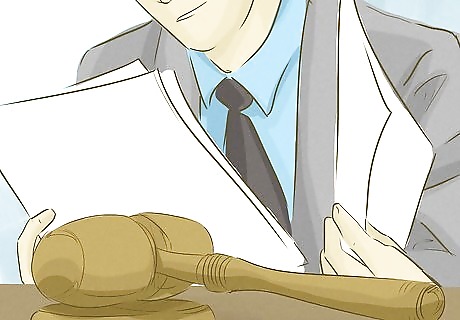
views
X
Research source
If you request a hearing on your motion, you will have the opportunity to present and argue your motion in front of the judge in open court. Otherwise, the judge will decide whether to grant or deny your motion based on the papers you and the other party file.[2]
X
Research source
Drafting Your Motion

Determine the type of motion you want to file. You first must analyze your case and decide what motions would be appropriate. Especially if you've just received notice of a lawsuit against you, the motion you want to file probably will be procedural in nature. If you believe the lawsuit was filed in the wrong court, you might file a motion to dismiss for lack of venue or lack of subject matter. You also want to find out what the statute of limitations is for the lawsuit. All states have deadlines after which people cannot file a lawsuit for certain claims. If that deadline has passed, you can file a motion to dismiss because the statute of limitations has run. For example, suppose you are in a car wreck and the other driver is injured. The statute of limitations in Colorado is three years for personal injury claims involving motor vehicles, but the other driver waited four years before he filed his lawsuit. You could file a motion to dismiss based on the fact that the statute of limitations has passed. Keep in mind that some motions, such as a motion for a change of venue, must be made before you respond to a lawsuit. If you file any response to the lawsuit without mentioning these issues, they are treated by the court as though you had waived any objection.

Review the rules of civil procedure. The Colorado Rules of Civil Procedure set forth deadlines and requirements for certain motions. Local rules also may have specifics regarding how motions should be formatted in each court. You can find county-specific information by selecting the county in which your court is located at https://www.courts.state.co.us/Courts/County/Choose.cfm. All Colorado Rules, including county court rules, also are available free to the public by LexisNexis, which is the official publisher of all Colorado state laws, at http://www.lexisnexis.com/hottopics/Colorado/. The basic rule for a motion's form is that it must be in writing, and must state the grounds for the motion and the order or relief you are seeking from the judge. To return to the car wreck example, if you are filing a motion to dismiss because the statute of limitations has expired, your grounds would be that the statute of limitations for personal injury lawsuits involving car wrecks is three years, and the lawsuit was not filed until four years after the wreck. You would need to provide proof of the date of the car wreck to support these grounds. The relief you are seeking is an order from the judge dismissing the lawsuit because the person waited too long to sue you.

Research the law that supports your motion. You must provide adequate legal grounds that demonstrate to the judge why he or she should grant your motion. For example, suppose you are served with a complaint against you, and you believe the case was filed in the wrong location. You potentially can file a motion for a change of venue. The judge will only grant your motion if you have legally acceptable grounds for requesting a change of venue. In Colorado, you can request a change of venue only if the complaint was not originally filed in the proper county, or if it would be more convenient for necessary witnesses if the trial was moved closer to them. To continue the example, suppose you were in a car accident in Boulder County. The plaintiff filed her lawsuit in Pueblo County, where both you and she reside; however, all the witnesses to the accident live in Boulder County. Therefore, you can file a motion in response to her Pueblo County lawsuit asking the court to change the venue to Boulder County. Keep in mind that if you're filing a motion for a change of venue, you must file your motion in the county where the case is currently filed – not the county to which you want the case transferred.

Contact the other side. Before you draft your motion, you should tell the other side about the motion you're planning to file and find out if they will accept it. In some instances, the other side may have no objection to your motion, in which case you could file a stipulated motion. It's far more likely that the judge will grant the motion if both sides are in agreement on it, and you won't need a court hearing on it. Contacting the other side ahead of time can save you both time and effort. Especially if the other party is represented by an attorney, they may resent you for filing a motion and hauling them to court on it when it's something to which they would have agreed if you'd only asked. If the lawsuit is in a Colorado federal court, you must begin your motion by telling the judge how you contacted the other side and what their response was to your motion. A federal judge most likely will deny your motion if you don't contact the other side first.

Search for forms. Many forms that are generally accepted for use throughout the state are available on the Colorado Judicial Branch's website. The forms include a general motion, which you should use only if you can't find a specific motion template that fits the motion you want to file. You can also find forms for certain types of motions, along with instructions for filling out the forms and filing them, on the Colorado Legal Services website.

Complete your documents. Include all facts that are relevant to your argument, attaching supporting exhibits if necessary. The names of the parties and case number should be copied exactly from the complaint or other court filings from the case. Your motion must have the same information as all other documents filed in that case. Colorado requires many motions to be verified if you are representing yourself. This means you must sign the verification section in the presence of a notary, who will notarize your signature. District Court clerks in most counties are notaries, so you can sign your forms in front of them rather than making a special trip to another notary. If you've had any witnesses draft affidavits in support of your motion, these also typically must be signed before a notary. Judges may make a decision to hold a hearing on the motion on a case-by-case basis. However, if you want to request a hearing, you must do so on your motion. Typically you would do so by writing "oral argument requested" or "hearing requested" in the motion's caption. After you've signed your documents, make at least two copies of them before you file them with the court. You will need a copy for your own records plus a copy for each other party in the case. The originals will be filed with the court.
Filing Your Motion

Take your motion to the clerk of court. You must file your motion in the same court where the related case is being heard if you want the judge to rule on it. This can sometimes get confusing if you're using the motion to request that the case be transferred to another court. However, you must always file your motion in the court where the case is currently being heard, not the court where you want it to be heard. You may have to pay a filing fee when you file your motion. Colorado filing fees for motions are either $55, $70, or $105 depending on the type of motion you're filing. If the motion is your first filing in the case, or if you're filing it along with an answer to a civil lawsuit, your fees may be as much as $376. If you cannot afford to pay the filing fees, you can file a motion to have the fees waived. You must include bank statements and pay stubs for the previous three months so the court can review your income and assets. If you qualify for the waiver, you won't have to pay any court fees for the duration of the case.

Have the other party served. The other party involved in the lawsuit must have legal notice of the motion you've filed. Motions forms typically include a certificate of service or a certificate of mailing. You must mail your motion to the other party (either directly to the other person or to his or her attorney) using certified mail with returned receipt requested. The returned receipt provides proof to the court that the other party had notice of the motion, in the event they do not respond to your motion. Pay attention to the dates you include on the certificate of service or certificate of mailing, because you must mail your motion to the other party on the same date as you've told the court you will.

Wait for a response. The other party may file a response opposing your motion, in which case you must conduct research to figure out how to overcome that argument. Once the other party has been served with your motion, they have 14 days to respond. This time period generally includes all calendar days, regardless of whether court is in session. If the case is being heard in a Colorado federal court, the other party will have 21 days to respond to your motion. Keep in mind that even if the other side does not respond to your motion, the judge still must decide whether to grant it.

Have your oral argument scheduled. If you requested oral argument, you may have to call the clerk of court to schedule it, or it may have automatically been scheduled when you filed your motion. Keep in mind that even if you didn't formally request an oral argument on your motion, the other side may request a hearing through their response. Additionally, the judge may decide to have a hearing on the motion.

Prepare for your hearing. Take notes and rehearse the argument you plan to present to the judge. You may want to go to court on a day when motions are being heard and watch the proceedings, so you have some idea of what to expect. You also will have the opportunity to familiarize yourself with the courthouse and the courtrooms, so you are comfortable with the setup and know where you will need to be on the day of your hearing. According to Rule 78 of the Colorado Rules of Civil Procedure, each court may establish specific times and days of the week to hear motions. You can call the clerk's office and find out when motion day is. Organize any documents or evidence you want to present so you can find it easily. If you have supporting documents, make sure you have enough copies for the judge and the other party.
Arguing Your Motion

Arrive at the courthouse. Make sure you arrive at least 30 minutes early so you have time to go through courthouse security and locate the correct courtroom. Review the courthouse rules before you leave so you can make sure you don't bring anything with you that isn't allowed in the courtrooms. You don't have to dress up or wear a suit to appear in court, but you should dress conservatively and respectfully. Wear clean, neat clothing that covers your body appropriately.

Present your motion. Since it's your motion, you typically will have the opportunity to present your argument first. There may be other motions being heard in the same courtroom on the same day as yours, but the judge will call your name or the name of the case when he or she is ready for you. When you hear your case called, stand and move to the front of the courtroom in front of the judge. You will need to make a brief statement telling the judge about the case and your motion. Try to limit your discussion as much as possible. You should write notes to which you can refer while you're speaking. Feel free to paraphrase what you wrote in your motion. For example, you might say "Your honor, I am here to ask that you dismiss this lawsuit against me because the statute of limitations has passed. While I admit that I was involved in a car accident with the plaintiff on July 4, 2010, he did not file his lawsuit until August 20, 2014. The Colorado statute of limitations for personal injuries sustained in car accidents is three years, and that deadline had passed when the plaintiff filed his lawsuit. Accordingly, his lawsuit should be dismissed. Thank you." Speak clearly and concisely, and get straight to the point. Tell the judge exactly what you want him or her to do, and the reasons you believe you are entitled to that action under the law. Stick to the facts, and don't go off on tangents or make emotional appeals that don't have anything to do with your motion.

Listen to the other side. The other party may present its argument in opposition to your motion. Pay careful attention to what the other side says, and take notes if you want to remember something that was said or bring it up again later. After the other side presents its argument, you may have the opportunity to respond. Don't interrupt the other party when he or she is speaking, or make noises intended to disrupt or distract. Each party must be given an opportunity to speak.

Receive the judge's decision. After the judge hears both sides, he or she will either grant or deny your motion. Although the judge may orally grant or deny your motion after your hearing, he or she typically will issue a written order. The written order also may explain the reasoning behind the judge's decision. If the judge denies your motion, that typically is the end of the matter. Arguing with the judge or attempting to persuade her to change her decision after it's already been made won't do you any favors and could result in the judge holding you in contempt of court.

















Comments
0 comment